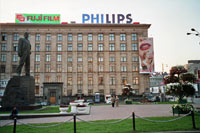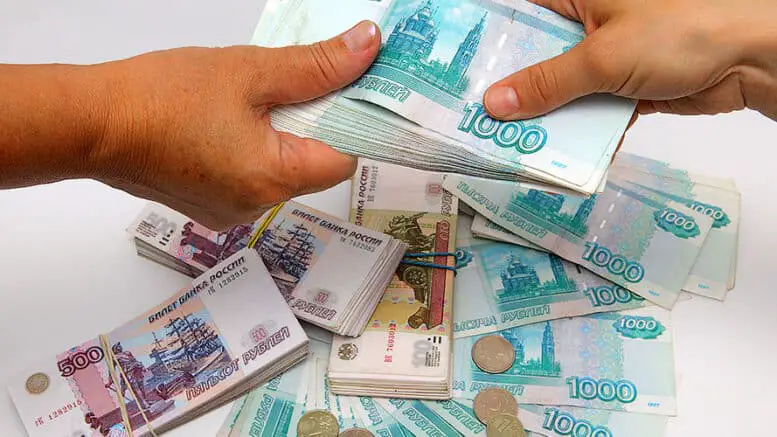The Soviet economy developed under Communist ideals for some seventy-five years. These ideals kept that development focused on what had been the centerpieces of 19th century economies: industry and agriculture. To maintain Communism’s place in world politics, all production was geared to support the military. However, during those seventy-five years capitalism modernized agriculture and industry, allowing for a large pool of surplus labor to create service-oriented economies that outstripped the Soviet state. By the time the lop-sided USSR tottered and fell, it was using four times as much GDP to support a military of comparable size with that in the US.
Capitalism arrived in Russia to find a population that neither wanted nor trusted it. It found decaying, cheaply built factories, substandard housing, and entire settlements built in economically unjustifiable locations. Advertising, banking, retail supply chains, and corporate governance did not exist in any form that could serve a free market.
The growth over the last fifteen years has been just as much about building infrastructure as about changing people’s attitudes toward the economy. This is a process that can take generations, especially if conducted under the pretexts of a free society where people are free to hold onto outdated modes of thought, even if they do not serve state needs.
One good turn…
The Russian economy saw improvement in some problematic areas in 2005.
First, “capital flight” abated. While the net inflow of personal assets was a modest 300 million, it shows that Russians are beginning to trust their economy, at least enough to keep their savings within Russia’s borders. If the trend continues, it may help fuel more widespread investment and spur still greater consumer confidence.
Second, new names appeared on Russia’s roster of billionaires. Andrei Rogachev and Sergei Galitsky have each built a chain of discount grocery stores. Rustam Tariko formed an import/export business in the 90s and now owns an empire of banking, insurance, and vodka. The importance of this, while not entirely a score for “honest business,” does show that wealth can be amassed in Russia without privatization deals, heretofore the source of all Russia’s billionaires. It shows that building businesses from scratch can be done, which could lead to greater public self-initiative.
Third, Russia has finally begun to transform itself into a more service-driven economy, as was recently noted in the annual Conference “The Investment Climate in Russia,” sponsored in part by the American Chamber of Commerce in Russia. As stated in the conference booklet, “as a share of GDP, the growth leader among types of activity was the hotel and restaurant sector 115.6% (103% in 2004), with trade and paid services at 112.3% (111.2%), construction at 109.7 % (110.1%) and the real estate business at 109.6% (103.1%). The Russian economy is thus undergoing a structural change involving an increase in the relative share of the market services and processing sectors.”
…deserves another.
These reversals have certainly not cleared all challenges to the Russian economy.
As mentioned before, in order for a service-oriented economy to truly prosper, industry and agriculture must first be modernized. The conference booklet states, “according to a poll taken by Rosstat in the fall of 2005, investments were made last year by 95% of large and medium size industrial enterprises and 40% of small businesses. Investments largely went toward the restoration of worn-out equipment… and only half of those polled indicated that their investments were aimed at raising productivity.” Russian businesses are still largely maintaining a status quo.
This is contributing to the non-competitiveness of Russian products on the Russian market and helping drive an overall decrease in production and exports. Nowhere is this more concerning than in the oil and gas sectors. While the monetary value of exports rose by a healthy 34.6%, the growth rate in the quantity of exports fell by almost half, to 4%. This trend is set to continue until billions of dollars are spent to open new fields. Since oil and gas represent the growing majority of exports (63.8% in 2005 and 57.6% in 2004), the slowdown will likely affect the entire Russian economy.
Investment in Russia now exceeds 20 billion USD annually, but is still not enough to diversify and grow the Russian economy quickly enough. This is the economy’s single largest threat.
Domestic Investment Issues
Russia’s banking system has been significantly strengthened by recent reforms, but is certainly not able to support such large-scale investment on its own. Russia formed its own version of the FDIC in 2005, drawing in 924 banks to a program that demands more transparency in banking practices and insures personal deposits of up to 100,000 RU. Personal and company deposits have risen by 30 and 40 percent, respectively. Personal loans, however, have risen at potentially drastic rate of nearly 80 percent, leading to a low solvency level. Furthermore, according to a study by Standard and Poor’s, Russian banks still are only half as transparent as Western banks. More needs to before Russian banking can match international standards.
Initial public offerings (IPOs) are a growing source of funds, but are not
always best for the Russian economy. The Russian stock market (RTS) has grown by 170% annually since 1999. 2005 saw thirteen major Russian IPOs at an average value of 346 million dollars (up from a yearly average of less than one at 128 million). Over the next three years, fifteen to thirty billion more dollars will be offered. Nevertheless, the RTS is still young and its investors largely speculative, causing many to chose foreign exchanges for IPOs. There is also reason to believe that Russian IPO offerings are largely a fad among investors and will soon slip in popularity.
The conference guide elaborates: “The Federal Financial Markets Service (FFMS) seeks to stimulate the development of the IPO market in the Russian financial system, because an emission offer on the foreign financial markets reduces the amount of trade on the Russian markets, obstructs the flow of capital into the Russian economy, and prevents the growth of capitalization of the Russian securities market. To draw issuers into the Russian trade markets, the FFMS has simplified the listing rules for IPOs, and brought Russian legislation in this sphere into harmony with the international standards.” Whether these reforms will be successful is yet to be seen.
Foreign Investment Issues
Russia’s most promising source of funds is foreign investment. Russia holds highly favorable sovereign ratings and its still growing and yet underserved economy is attracting the attention of investors and companies. When the FIAC asked potential investors if they would invest in Russia in the next three years, 65% said yes. 71% of current investors will invest more.

The Ministry of Economic Development and Trade, located on Mayakovsky Sq. controls and monitors most aspects of the Russian economy.
The Russian government is also finally beginning to consolidate and to focus on long-term planning, rather than short-term crisis resolution. There are plans in place to raise bank equity, decrease inflation, encourage private-public partnerships in infrastructure building, double the government’s base wage by 2008, and raise pensions to a subsistence level. However, in deciding on and implementing these plans, the government has also revealed some of its own weaknesses.
In a particularly vocal debate, Prime Minister Mikhail Fradkov offered to reduce VAT (one of Russia’s main taxes) from 18 to 13 percent, arguing that tax reductions encourage domestic and foreign investment. However, other cabinet members argued that Russia would not be able to compensate for this lost income, which is needed for capital investments and reforming government institutions. The resulting political “wars” left Fradkov nearly powerless in government and left investors questioning whether Russia has a clear chain of command or decision-making strategy.
In a poll by the World Bank Group, only 19% of investors said that taxes adversely affect Russia’s investment climate. 51% named political uncertainty and macroeconomic instability. Contributing to this opinion are Russia’s still half-Soviet, half-capitalist accounting and tax regulations, recent public outcries over botched attempts to reform social services, the uncovering of wide-spread abuse of Russian soldiers, concern over political pressures on the judiciary, corruption among police, and a faltering electrical grid. These challenges will require legislation and considerable tax dollars to remedy. Russia is better off concentrating on institutional reform rather than reducing taxes.
Outlook for the Near Future
Economists have predicted several worst-case scenarios for Russia. A drop in oil prices coupled with a strengthening ruble could lead to a banking crisis as the flow of currencies reverses. In other variant, Russia could catch “Dutch disease:” high export prices strengthen the currency, encouraging imports and collapsing local industry.
While these sorts of catastrophes are not likely, the problem of lagging investment will soon cause further decreases in exports for which the still little-diversified economy will not be able to compensate. The approaching end to the current political cycle, which usually entails heightened political uncertainty, may also contribute to the economic dip with a decrease in investment.
Downturns are natural in economic cycles and sometimes even necessary for further growth. To quote the conference guide a final time, “the downward trend in the quantity of exports will persist over the next few years, and the potential for further growth in export earning will thus be limited. The strengthening ruble, growing personal income, and the liberalization of foreign trade should promote accelerated growth in imports, and Russian products, in conditions of growing competition, will be less in demand on a number of markets for consumer goods and investment goods in particular. This will lead to a reduction in both the trade balance and the influx of foreign currency into the Russian economy, which will in turn hold down rates of growth in the money supply and retard the growth mechanism that has developed in recent years but at the same time further strengthen the ability of Russian products to compete with imports and stimulate modernization, thereby promoting a growth in investments.”
Yet, as stated above, these challenges are not stopping new investment. While there are challenges to face, the Russian economy, with one of the best educated labor forces in the world and a good share of the world’s energy and mineral resources, is certainly capable of growth in the long term. Gains and profits will not be as easily won as they were in Russia’s “wild east days” of the 90s, or even in the first years of the 21st century. However, that is the nature of a developing economy.
The preceding text was produced largely from information gathered on March 1, 2006 at the “The Economy and Investment Climate in Russia,” an annual event sponsored in part by the American Chamber of Commerce in Russia. This “snapshot” is intended for students seeking to formulate theses or teachers seeking to stimulate classroom discussion. While it is a good introduction, it should not be taken as a full encapsulation of all factors and opinions surrounding the Russian economy. There are, for example, many theories on the USSR’s demise not covered and several recent events omitted (such as the Yukos affair). For further study, we suggest starting with the SRAS Library’s entry for Business in Russia.






